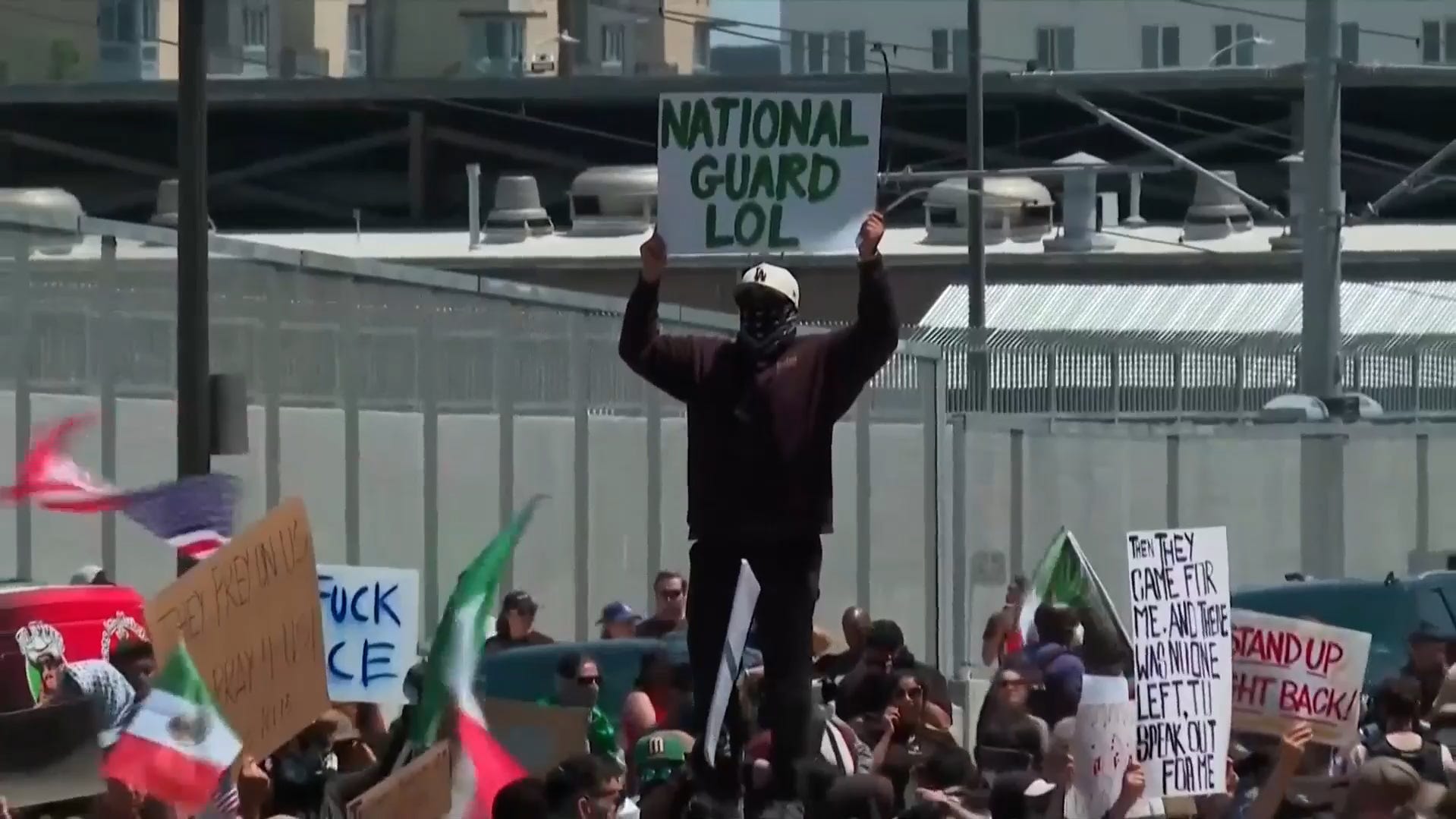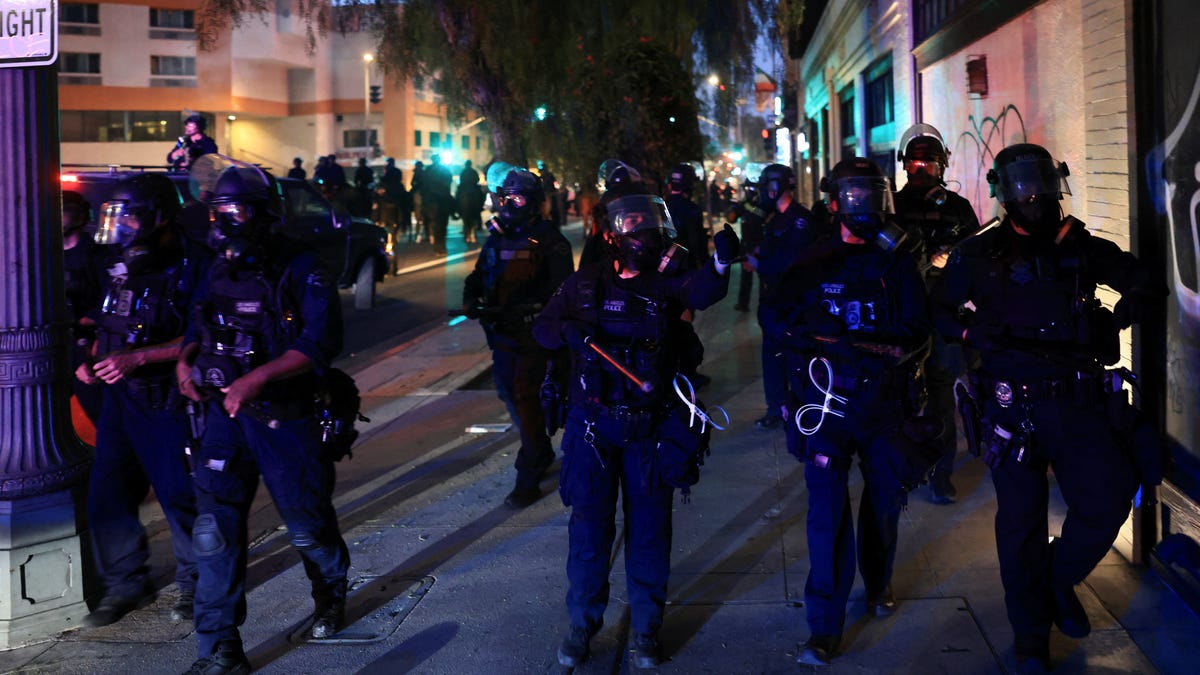
Trump sends National Guard to LA as ICE protests escalate
Crowds converged in downtown L.A. after National Guard troops arrived to quell any protests opposing President Trump’s immigration policies.
Protests erupted in Los Angeles over President Trump’s immigration crackdown, leading to clashes with law enforcement and the deployment of the National Guard.The protests were sparked by immigration raids that resulted in dozens of arrests, including a labor union president.President Trump defended the raids and deployments, citing attacks on ICE officers, while critics argue the enforcement violates civil rights.ICE detentions have surged above 50,000 for the first time since 2019, as the administration aims to deport 1 million people annually.
Tensions escalated over the weekend between law enforcement and protesters in Los Angeles speaking out against President Donald Trump’s crackdown on immigration.
According to USA TODAY, the protests started small and intensified throughout the weekend, with protesters and federal officials blaming each other for the escalation. In response, Trump ordered the deployment of 2,000 National Guard members on Saturday, June 7, despite the objections of Los Angeles Mayor Karen Bass and California Gov. Gavin Newsom.
In a statement, the White House said that “violent mobs have attacked ICE Officers and Federal Law Enforcement Agents carrying out basic deportation operations in Los Angeles, California,” making the deployment necessary. Trump, his border czar Tom Homan and other federal officials have also said they will charge anyone who interfered with the immigration operation.
Here’s what to know about the LA protests and what Florida’s laws for protesting look like.
What are the LA, California protests about? When did the LA protests start?
The Los Angeles protests targeted the Trump administration’s crackdown on immigration enforcement. Protestors allege the Trump administration’s immigration enforcement has violated civil and human rights.
The protests began on June 6, following four different search raids around the city. At least 44 people were arrested, and the president of the Service Employees International Union, David Huerta, was arrested for allegedly interfering with federal officers.
According to USA TODAY, more than 100 people gathered at the immigration services building and detention center in downtown Los Angeles to protest the raids, with the Los Angeles Police Department declaring it an unlawful assembly and ordering the crowd to disperse.
Some protesters threw pieces of broken concrete at the officers, who responded by firing tear gas and pepper spray. They also used flash-bang concussion rounds to disperse the crowd.
Larger protests started to break out across the Los Angeles area over the weekend, seeing hundreds of demonstrators gathered at each site.
What does ‘ICE’ stand for? Who does ICE deport?
The U.S. Immigration and Customs Enforcement (ICE) was created in 2003 under the Department of Homeland Security to protect the U.S. from cross-border crime and illegal immigration.
ICE enforces the nation’s complex Title 8 immigration laws inside the country, and U.S. Customs and Border Protection handles them at the nation’s borders. ICE has over 20,000 law enforcement officers and an annual budget of about $8 billion.
As for who specifically ICE is deporting, it depends on who you ask.
“ICE detains individuals as necessary, including to secure their presence for immigration proceedings and removal from the United States,” the agency says on its website. “ICE also detains those who are subject to mandatory detention under U.S. immigration law and those a supervisor has determined are public safety or flight risks.”
The president, who declared a national border emergency on his first day in office and ordered the U.S. armed forces to repel “forms of invasion,” has said his administration will prioritize deporting undocumented immigrants with criminal histories.
However, USA TODAY has reported that thousands who have been deported do not have a criminal record. ICE also detained an American citizen in Florida in April of this year for 30 hours.
What happens to people after ICE arrests them?
After ICE arrests and processes people or takes them into custody after other law enforcement agencies turn them over, they may detain them while their immigration cases are pending or release them under supervision.
“Officials make custody determinations on an individual basis, taking into account all facets of a person’s situation, including their immigration history and criminal records. Authorities also consider family ties, humanitarian issues and whether a person may be a flight risk,” ICE said.
The Trump Administration has since issued executive orders authorizing the expansion of “expedited removal,” which allows the U.S. to deport someone without a hearing and revoking a ban on ICE arrests in sensitive areas such as hospitals, schools, and churches.
How many people has ICE detained in 2025?
According to the Transactional Records Access Clearinghouse website, as of June 1, ICE has detained 51,302 people in its facilities. This is the first time that number has surpassed 50,000 since September 2019.
The White House has set a goal of removing 1 million people annually. “If we don’t get these criminals out of our country, we are not going to have a country any longer,” Trump posted on social media on April 21.
What are the protest laws in Florida?
Florida Statutes 871.015 state that a person may not “knowingly engage in protest activities or knowingly cause protest activities to occur within 500 feet of the property line of a residence, cemetery, funeral home, house of worship, or other location during or within 1 hour before or 1 hour after the conducting of a funeral or burial at that place.”
It also states that a person who violates this will be charged with a misdemeanor of the first degree.
In 2021, Gov. Ron DeSantis signed HB 1, an anti-protest law that enhances criminal penalties during specific gatherings and creates new criminal penalties for “mob intimidation” and damaging or pulling down historic objects. As of 2024, the Florida Supreme Court ruled unanimously that the law does not apply to those present at a protest but don’t engage in violent or disorderly conduct.
According to the ACLU of Florida, the First Amendment generally prohibits restrictions based on speech content; however, this does not mean that the Constitution completely protects all types of speech in every circumstance.
“For example, threatening someone with violence is not protected,” the organization writes on its website. “Additionally, government officials are allowed to place certain reasonable, nondiscriminatory, and narrowly drawn ‘time, place, and manner’ restrictions on the exercise of First Amendment rights.
They also note that protesting and picketing must be done in an orderly, non-disruptive fashion so that pedestrians can pass by and entrances to buildings are not blocked.
What to know before attending any protests in Florida
Human Rights Campaign has tips for those participating in a peaceful protest to help ensure their safety and well-being:
Properly prepare: Dress for the weather, pack the necessary supplies (cash, water, extra battery, etc), have at least one emergency contact, and plan to share your status throughout the protest.Know the environment: Research the location beforehand and have an offline-accessible map to reference if the service is spotty. Have multiple routes into and out of the protest area.Stay Aware: Maintain “360 situational awareness”— always know what is happening around you. If you see something, say something.Observe, Orient, Decide, Act: The “OODA Loop” (Observe, Orient, Decide, Act) is a helpful framework to stay calm and make decisions during high-stress situations:Observe: Identify the source of danger and your surroundingsOrient: Determine where you are and where you need to goDecide: Choose a course of action that minimizes riskAct: Implement your decision and stay aware of changes in the environmentGov. DeSantis comments on LA protests
DeSantis took to X, formerly Twitter, to quote-tweet a video of the protests. The video shows some protestors on bikes circling a burning car; one of them has a Mexican flag fixed to their bike.
“What an upside down world,” DeSantis said in his tweet.
In another tweet, he condemned news outlets for using the word “protests” over “riots.”
ICE agents detain over 100 people at Tallahassee construction site, protests ensue
Homeland Security Investigations (under ICE), along with the Florida Highway Patrol and other Florida and federal law enforcement agencies, conducted one of Florida’s largest immigration raids on May 29 at a student housing development construction site in Tallahassee.
Immigration agents detained more than 100 people at the construction site, according to reports. In the days after, more than 400 people gathered at the Florida Capitol to protest the raid, including the family members of those detained.
Over a week later, several questions remain unanswered about this raid. The warrant for the raid, filed in U.S. District Court for the Northern District of Florida and signed by U.S. Magistrate Judge Martin A. Fitzpatrick, is still sealed.
Contributing: USA TODAY and Ana Goñi-Lessan, USA TODAY NETWORK – Florida
